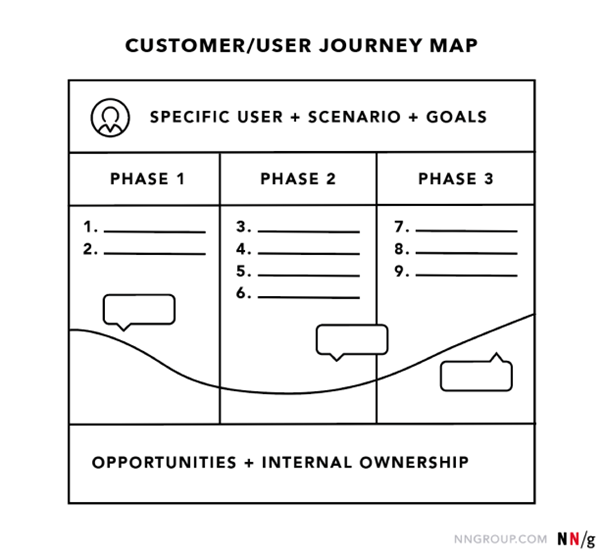A journey map provides a holistic view of the user experience by identifying moments of frustration and delight throughout a series of interactions.
Journey mapping can help to reveal opportunities to address customers’ pain points, alleviate fragmentation, and, ultimately, create a better experience for your users.

Source: Nielsen Norman Group
A journey map can also be called a:
- user journey
- customer journey
- experience journey
- employee journey
When using journey maps, remember to consider what happens before and after the core experience, even when it includes the interaction with other services and providers.
How to complete a user journey map
Journey maps come in all shapes and sizes. Regardless of how they look, journey maps have the following 5 key elements in common:
-
Actor. The actor is the persona or user who experiences the journey. The actor is who the journey map is about and offers their point of view. Actors will help you to define the actions in the map and ensure you root the map in data and evidence. Each map should only cover to build a strong, clear narrative.
-
Scenario and expectations. The scenario describes the situation that the journey map addresses and is associated with an actor’s goal or need. Scenarios can be real (for existing products and services) or anticipated — for products that are yet in the design stage.
-
Journey phases. Journey phases are the different high-level stages in the journey. They provide organisation for the rest of the information in the journey map (actions, thoughts, and emotions). The stages will vary from scenario to scenario.
-
Actions, mindsets, and emotions. These are behaviours, thoughts, and feelings the actor has throughout the journey and that are mapped within each of the journey phases. Emotions are plotted as a single line across the journey phases, showing the pain points and areas of delight throughout the user experience.
-
Opportunities. Opportunities are insights gained from mapping; they speak to how the user experience can be improved.
